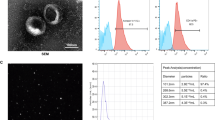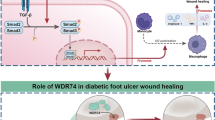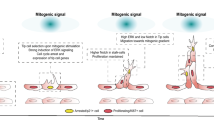Abstract
Niacin was shown to inhibit acute vascular inflammation and improves endothelial dysfunction independent of changes in plasma lipids. Here, we investigated whether niacin can increase blood flow recovery after tissue ischemia by enhancing endothelial progenitor cell (EPC) functions in diabetic mice. Starting at 4 weeks after the onset of diabetes, vehicle or niacin (40 mg/kg/day) was administered daily by gavage to streptozotocin (STZ)-induced diabetic mice and diabetic endothelial nitric oxide synthase (eNOS)-deficient mice. Unilateral hindlimb ischemia surgery was conducted after 2 weeks of vehicle or niacin treatment. Compared to the control group, the niacin group had significantly increased ischemic/non-ischemic limb blood perfusion ratio and higher capillary density. These effects were markedly reduced in STZ-induced diabetic eNOS-deficient mice. Flow cytometry analysis showed impaired EPC-like cell (Sca-1+/Flk-1+) mobilization after ischemia surgery in diabetic mice but augmented mobilization in the mice treated with niacin. Diabetes was induced by administering STZ to FVB mice that received eGFP mouse bone marrow cells to evaluate effects of niacin on bone marrow-derived EPC homing and differentiation to endothelial cells. Differentiation of bone marrow-derived EPCs to endothelial cells in the ischemic tissue around vessels in diabetic mice that received niacin treatment, was significantly increased than that in control group. By in vitro studies, incubation with niacin in high-glucose medium reduced H2O2 production, cell apoptosis, and improved high glucose-suppressed EPC functions by nitric oxide-related mechanisms. Our findings demonstrate that niacin increases blood flow recovery after tissue ischemia in diabetic mice through enhancing EPC mobilization and functions via nitric oxide-related pathways.







Similar content being viewed by others
References
The DCCT/EDIC Study Research Group (2005) Intensive diabetes treatment and cardiovascular disease in patients with type 1 diabetes. N Engl J Med 353:2643–2653
Adeghate E (2004) Molecular and cellular basis of the etiology and management of diabetic cardiomyopathy: a short review. Mol Cell Biochem 261:187–191
Federman DG, Bravata DM, Kirsner RS (2004) Peripheral arterial disease. A systemic disease extending beyond the affected extremity. Geriatrics 59:29–30
Asahara T, Murohara T, Sullivan A et al (1997) Isolation of putative progenitor endothelial cells for angiogenesis. Science 275:964–967
Vasa M, Fichtlscherer S, Aicher A et al (2001) Number and migratory activity of circulating endothelial progenitor cells inversely correlate with risk factors for coronary artery disease. Circ Res 89:1–7
Fadini GP, de Kreutzenberg S, Albiero M et al (2008) Gender differences in endothelial progenitor cells and cardiovascular risk profile: the role of female estrogens. Arterioscler Thromb Vasc Biol 28:997–1004
Chen YH, Lin SJ, Lin FY et al (2007) High glucose impairs early and late endothelial progenitor cells by modifying nitric oxide-related but not oxidative stress-mediated mechanisms. Diabetes 56:1559–1568
Meyers CD, Kamanna VS, Kashyap ML (2004) Niacin therapy in atherosclerosis. Curr Opin Lipidol 15:659–665
Kamanna VS, Kashyap ML (2007) Nicotinic acid (niacin) receptor agonists: will they be useful therapeutic agents? Am J Cardiol 100:53–61
Brown BG, Zhao XQ, Chait A et al (2001) Simvastatin and niacin, antioxidant vitamins, or the combination for the prevention of coronary disease. N Engl J Med 345:1583–1592
Taylor AJ, Sullenberger LE, Lee HJ, Lee JK, Grace KA (2004) Arterial biology for the investigation of the treatment effects of reducing cholesterol (ARBITER) 2: a double-blind, placebo-controlled study of extended-release niacin on atherosclerosis progression in secondary prevention patients treated with statins. Circulation 110:3512–3517
Vittone F, Chait A, Morse JS, Fish B, Brown BG, Zhao XQ (2007) Niacin plus simvastatin reduces coronary stenosis progression among patients with metabolic syndrome despite a modest increase in insulin resistance: a subgroup analysis of the HDL-Atherosclerosis Treatment Study (HATS). J Clin Lipidol 1:203–210
Kuvin JT, Rämet ME, Patel AR, Pandian NG, Mendelsohn ME, Karas RH (2002) A novel mechanism for the beneficial vascular effects of high-density lipoprotein cholesterol: enhanced vasorelaxation and increased endothelial nitric oxide synthase expression. Am Heart J 144:165–172
Warnholtz A, Wild P, Ostad MA et al (2009) Effects of oral niacin on endothelial dysfunction in patients with coronary artery disease: results of the randomized, double-blind, placebo-controlled INEF study. Atherosclerosis 204:216–221
Kuvin JT, Dave DM, Sliney KA et al (2006) Effects of extended-release niacin on lipoprotein particle size, distribution, and inflammatory markers in patients with coronary artery disease. Am J Cardiol 98:743–745
Ganji SH, Qin S, Zhang L, Kamanna VS, Kashyap ML (2009) Niacin inhibits vascular oxidative stress, redox-sensitive genes, and monocyte adhesion to human aortic endothelial cells. Atherosclerosis 202:68–75
Tavintharan S, Lim SC, Sum CF (2009) Effects of niacin on cell adhesion and early atherogenesis: biochemical and functional findings in endothelial cells. Basic Clin Pharmacol Toxicol 104:206–210
Rosenson RS (2003) Antiatherothrombotic effects of nicotinic acid. Atherosclerosis 171:87–96
Huang PH, Tsai HY, Wang CH et al (2010) Moderate intake of red wine improves ischemia-induced neovascularization in diabetic mice–roles of endothelial progenitor cells and nitric oxide. Atherosclerosis 212:426–435
Huang PH, Chen YH, Wang CH et al (2009) Matrix metalloproteinase-9 is essential for ischemia-induced neovascularization by modulating bone marrow-derived endothelial progenitor cells. Arterioscler Thromb Vasc Biol 29:1179–1184
Huang PH, Huang SS, Chen YH et al (2010) Increased circulating CD31 +/annexin V + apoptotic microparticles and decreased circulating endothelial progenitor cell levels in hypertensive patients with microalbuminuria. J Hypertens 28:1655–1665
Matoba T, Shimokawa H, Nakashima M et al (2000) Hydrogen peroxide is an endothelium-derived hyperpolarizing factor in mice. J Clin Invest 106:1521–1530
Loomans CJ, de Koning EJ, Staal FJ et al (2004) Endothelial progenitor cell dysfunction: a novel concept in the pathogenesis of vascular complications of type 1 diabetes. Diabetes 53:195–199
Tepper OM, Galiano RD, Capla JM et al (2002) Human endothelial progenitor cells from type II diabetics exhibit impaired proliferation, adhesion, and incorporation into vascular structures. Circulation 106:2781–2786
Fadini GP, Sartore S, Albiero M et al (2006) Number and function of endothelial progenitor cells as a marker of severity for diabetic vasculopathy. Arterioscler Thromb Vasc Biol 26:2140–2146
Fadini GP, Sartore S, Schiavon M et al (2006) Diabetes impairs progenitor cell mobilisation after hindlimb ischaemia-reperfusion injury in rats. Diabetologia 49:3075–3084
Thoenes M, Oguchi A, Nagamia S et al (2007) The effects of extended-release niacin on carotid intimal media thickness, endothelial function and inflammatory markers in patients with the metabolic syndrome. Int J Clin Pract 61:1942–1948
Wu BJ, Yan L, Charlton F, Witting P, Barter PJ, Rye KA (2010) Evidence that niacin inhibits acute vascular inflammation and improves endothelial dysfunction independent of changes in plasma lipids. Arterioscler Thromb Vasc Biol 30:968–975
Yan Q, Briehl M, Crowley CL, Payne CM, Bernstein H, Bernstein C (1999) The NAD+ precursors, nicotinic acid and nicotinamide upregulate glyceraldehyde-3-phosphate dehydrogenase and glucose-6-phosphate dehydrogenase mRNA in Jurkat cells. Biochem Biophys Res Commun 255:133–136
Meister A, Anderson ME (1983) Glutathione. Annu Rev Biochem 52:711–760
Avogaro A, Fadini GP (2006) The Janus face of nicotinic angiogenesis. J Am Coll Cardiol 48:2561–2563
Harwood DT, Kettle AJ, Winterbourn CC (2006) Production of glutathione sulfonamide and dehydroglutathione from GSH by myeloperoxidase-derived oxidants and detection using a novel LC-MS/MS method. Biochem J 399:161–168
Sugiyama S, Kugiyama K, Aikawa M, Nakamura S, Ogawa H, Libby P (2004) Hypochlorous acid, a macrophage product, induces endothelial apoptosis and tissue factor expression: involvement of myeloperoxidase-mediated oxidant in plaque erosion and thrombogenesis. Arterioscler Thromb Vasc Biol 24:1309–1314
Acknowledgments
This study was supported, in part, by the following research grants: the National Science Council, NSC 98-2314-B-075-035, and UST-UCSD International Centre of Excellence in Advanced Bio-engineering NSC-99-2911-I-009-101-A2; VGH-V98B1-003 and VGH-V100E2-002 from Taipei Veterans General Hospital; and a grant from the Ministry of Education’s ‘Aim for the Top University’ Plan. Funding agencies had no role in study design, data collection, analysis, decision to publish, or preparation of the manuscript.
Conflict of interest
None.
Author information
Authors and Affiliations
Corresponding authors
Rights and permissions
About this article
Cite this article
Huang, PH., Lin, CP., Wang, CH. et al. Niacin improves ischemia-induced neovascularization in diabetic mice by enhancement of endothelial progenitor cell functions independent of changes in plasma lipids. Angiogenesis 15, 377–389 (2012). https://doi.org/10.1007/s10456-012-9267-z
Received:
Accepted:
Published:
Issue Date:
DOI: https://doi.org/10.1007/s10456-012-9267-z




